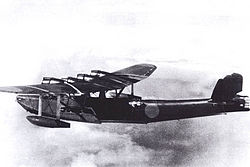Kawanishi H6K
| Kawanishi H6K | |
|---|---|

|
|
| Type: | Flying boat |
| Design country: | |
| Manufacturer: |
Kawanishi |
| First flight: |
July 14, 1936 |
| Number of pieces: |
217 |
The Kawanishi H6K was Japan's first four-engine multi - purpose flying boat in modern all-metal construction.
history
It was designed in 1935 based on experience with British Short and German Rohrbach licensed buildings. The first flight took place on July 14, 1936. The machine, of which 217 were built by 1943, was used as a reconnaissance, transport and combat aircraft. Some H6K flew with special radio equipment as commanding and command aircraft. Because of the insufficient speed, armament and armor, the type was only used in night operations from 1943 onwards. The allied name is Mavis .
construction
The H6K was a semi-cantilever high -wing aircraft in all-metal construction with double vertical stabilizers and double controls. The bottom of the hull and the support float were stepped and keeled. Four 14-cylinder double-star Mitsubishi Kinsei 51 engines, each with 1000 hp in the wing, served as drive . The armament consisted of three command posts in the bow, back of the fuselage and stern with single or twin machine guns. Up to 1600 kg of drop ammunition could be carried on the wing struts.
Versions
- H6K1 ( Type 97 ): Designation for the first, third and fourth prototype after installation of Mitsubishi Kinsei 43 engines (746 kW / 1000 PS)
- H6K2 ( Type 97 Model 11 ): original series model developed from the fifth prototype with minor changes in the equipment, 10 pieces built
- H6K2-L : unarmed version of the transporter, similar to the early H6K4 , for 16 passengers, Japan Air Lines took over 18 planes
- H6K3 : Name for two H6K2s completed as VIP vans for 16 passengers
- H6K4 ( Type 97 Model 11 ): most important production model with increased fuel capacity, modified armament and with Kinsei 46 engines (798 kW / 1070 PS) installed from August 1941
- H6K4-L : unarmed transport version with more cabin windows; 147 copies were made together with the H6K4
- H6K5 ( Type 97 Model 23 ): last production model with Kinsei 51 or Kinsei 53 engines and new armament, only 70 units were made from August 1942 to 1943
Technical specifications
| Parameter | H6K3 | H6K5 |
|---|---|---|
| crew | 8th | ? |
| length | 25.40 m | 25.63 m |
| span | 39.95 m | 40.00 m |
| height | 6.20 m | 6.27 m |
| Wing area | 170 m² | |
| Empty mass | 11,750 kg | 12,380 kg |
| Takeoff mass | normal 20,430 kg max. 22,000 kg |
Max. 23,000 kg |
| Cruising speed | 230 km / h at an altitude of 2000 m | ? |
| Top speed | 362 km / h at an altitude of 2000 m | 385 km / h at an altitude of 6000 m |
| Summit height | normal 4800 m maximum 6000 m |
9560 m |
| Rate of climb | 200 m / min | ? |
| Range | normal 4600 km max. 7000 km |
Max. 6775 km |
| Radius of action | 2100 km | ? |
| Flight duration | 20 h at 230 km / h | ? |
| Engines | 4 × Mitsubishi Kinsei 51 or Kinsei 53 , each 969 kW (1300 PS) | |
| Armament | ? | 4 × 7.7 mm MG Type 92 20 mm cannon in the rear cockpit |
| Drop ammunition | 1000 kg bombs or two 800 kg torpedoes | |
See also
literature
- René J. Francillon: Japanese Aircraft of the Pacific War , US Naval Institute Press, 1987, ISBN 978-0-87021-313-7